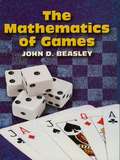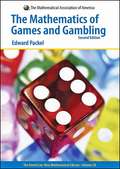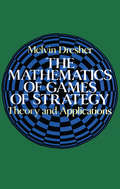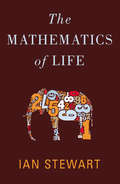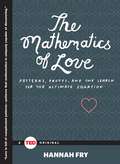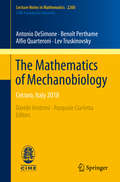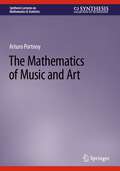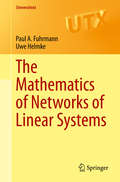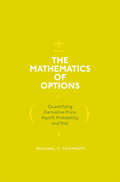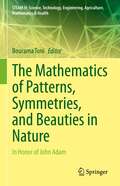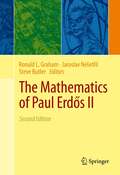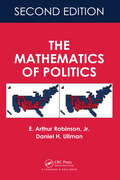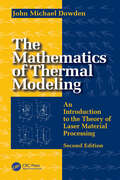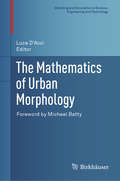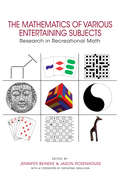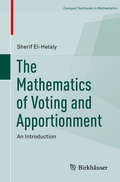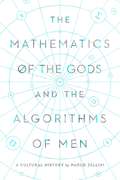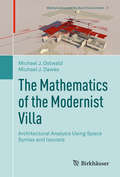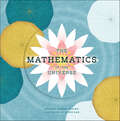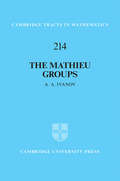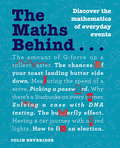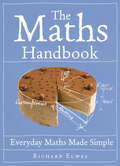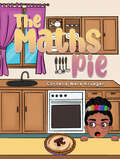- Table View
- List View
The Mathematics of Games
by John D. BeasleyIf playing games is natural for humans, analyzing games is equally natural for mathematicians. Even the simplest of games involves the fundamentals of mathematics, such as figuring out the best move or the odds of a certain chance event. This entertaining and wide-ranging guide demonstrates how simple mathematical analysis can throw unexpected light on games of every type--games of chance, games of skill, games of chance and skill, and automatic games.Just how random is a card shuffle or a throw of the dice? Is bluffing a valid poker strategy? How can you tell if a puzzle is unsolvable? How large a role does luck play in games like golf and soccer? This book examines each of these issues and many others, along with the general principles behind such classic puzzles as peg solitaire and Rubik's cube. Lucid, instructive, and full of surprises, it will fascinate mathematicians and gamesters alike.
The Mathematics of Games and Gambling (Anneli Lax New Mathematical Library #28)
by Edward W. Packel<p>The first edition of this book was reprinted eight times. This book introduces and develops some of the important and beautiful elementary mathematics needed for rational analysis of various gambling and game activities. Most of the standard casino games (roulette, blackjack, keno), some social games (backgammon, poker, bridge) and various other activities (state lotteries, horse racing, etc.) are treated in ways that bring out their mathematical aspects. The mathematics developed ranges from the predictable concepts of probability, expectation, and binomial coefficients to some less well-known ideas of elementary game theory. The second edition includes new material on: sports betting and the mathematics behind it; Game theory applied to bluffing in poker and related to the Texas Holdem phenomenon; The Nash equilibrium concept and its emergence in the popular culture; Internet links to games and to Java applets for practice and classroom use. <p>The only formal mathematics background the reader needs is some facility with high school algebra. Game-related exercises are included at the end of most chapters for readers interested in working with and expanding ideas treated in the text. Solutions to some of the exercises appear at the end of the book.</p>
The Mathematics of Games of Strategy: Theory And Applications (Dover Books on Mathematics)
by Melvin DresherMelvin Dresher, noted research mathematician for the Rand Corporation, puts forth an exceptionally clear presentation of the mathematical theory of games of strategy and its applications to many fields including: economics, military, business, and operations research. The mathematical presentation is elementary in the sense that no advanced algebra or non-elementary calculus occurs in most of the mathematical proofs.The author presents game theory as a branch of applied mathematics. In addition to developing a mathematical theory for solving games, he shows how to formulate a game model associated with a given competitive or conflicting situation. Furthermore, he shows how some decision problems, such as timing of decisions, which do not resemble game situations, can be analyzed as a game, yielding rich insights into the decision problems.Beginning with an exposition of games of strategy, with examples from parlor games as well as military games, Dr. Dresher proceeds to treat the basic topics in the theory of finite games, i.e., the existence of optimal strategies and their properties. An elementary proof of the minimax theorem is given that provides an efficient method for computing optimal strategies.Since many games involve an infinite number of strategies, succeeding chapters deal with such games by first developing the necessary mathematics (e.g., probability distribution functions and Stieltjes integrals) for analyzing infinite games. The results of infinite games are then applied to two general classes of games — timing games and tactical games. A final chapter provides an application of moment space theory to the solution of infinite games.This is a book about decision making in the absence of perfect information. In particular, it analyzes decision problems in a competitive environment where conflicting interests exist, and uncertainties and risk are involved. For the reader who is interested in the applications of the theory of games of strategy to military, economic, or political problems, or to decision making in business, operations research, or the behavior sciences, it will prove a most rewarding study.
The Mathematics of Life: The New Mathematics Of The Living World
by Ian StewartBiologists have long dismissed mathematics as being unable to meaningfully contribute to our understanding of living beings. Within the past ten years, however, mathematicians have proven that they hold the key to unlocking the mysteries of our world--and ourselves. In The Mathematics of Life, Ian Stewart provides a fascinating overview of the vital but little-recognized role mathematics has played in pulling back the curtain on the hidden complexities of the natural world--and how its contribution will be even more vital in the years ahead. In his characteristically clear and entertaining fashion, Stewart explains how mathematicians and biologists have come to work together on some of the most difficult scientific problems that the human race has ever tackled, including the nature and origin of life itself.
The Mathematics of Love: Patterns, Proofs, and the Search for the Ultimate Equation (TED Books)
by Hannah FryIn this must-have for anyone who wants to better understand their love life, a mathematician pulls back the curtain and reveals the hidden patterns—from dating sites to divorce, sex to marriage—behind the rituals of love.The roller coaster of romance is hard to quantify; defining how lovers might feel from a set of simple equations is impossible. But that doesn’t mean that mathematics isn’t a crucial tool for understanding love. Love, like most things in life, is full of patterns. And mathematics is ultimately the study of patterns—from predicting the weather to the fluctuations of the stock market, the movement of planets or the growth of cities. These patterns twist and turn and warp and evolve just as the rituals of love do. In The Mathematics of Love, Dr. Hannah Fry takes the reader on a fascinating journey through the patterns that define our love lives, applying mathematical formulas to the most common yet complex questions pertaining to love: What’s the chance of finding love? What’s the probability that it will last? How do online dating algorithms work, exactly? Can game theory help us decide who to approach in a bar? At what point in your dating life should you settle down? From evaluating the best strategies for online dating to defining the nebulous concept of beauty, Dr. Fry proves—with great insight, wit, and fun—that math is a surprisingly useful tool to negotiate the complicated, often baffling, sometimes infuriating, always interesting, mysteries of love.
The Mathematics of Mechanobiology: Cetraro, Italy 2018 (Lecture Notes in Mathematics #2260)
by Benoît Perthame Alfio Quarteroni Lev Truskinovsky Antonio DeSimoneThis book presents the state of the art in mathematical research on modelling the mechanics of biological systems – a science at the intersection between biology, mechanics and mathematics known as mechanobiology. The book gathers comprehensive surveys of the most significant areas of mechanobiology: cell motility and locomotion by shape control (Antonio DeSimone); models of cell motion and tissue growth (Benoît Perthame); numerical simulation of cardiac electromechanics (Alfio Quarteroni); and power-stroke-driven muscle contraction (Lev Truskinovsky).Each section is self-contained in terms of the biomechanical background, and the content is accessible to all readers with a basic understanding of differential equations and numerical analysis. The book disentangles the phenomenological complexity of the biomechanical problems, while at the same time addressing the mathematical complexity with invaluable clarity. The book is intended for a wide audience, in particular graduate students and applied mathematicians interested in entering this fascinating field.
The Mathematics of Music and Art (Synthesis Lectures on Mathematics & Statistics)
by Arturo PortnoyThis book explores the relationships between music, the sciences, and mathematics, both ancient and modern, with a focus on the big picture for a general audience as opposed to delving into very technical details. The language of music is deciphered through the language of mathematics. Readers are shown how apparently unrelated areas of knowledge complement each other and in fact propel each other’s advancement. The presentation as well as the collection of topics covered throughout is unique and serves to encourage exploration and also, very concretely, illustrates the cross- and multidisciplinary nature of knowledge. Inspired by an introductory, multidisciplinary course, the author explores the relationships between the arts, sciences, and mathematics in the realm of music. The book has no prerequisites; rather it aims to give a broad overview and achieve the integration of the three presented themes. Mathematical tools are introduced and used to explain various aspects of music theory, and the author illustrates how, without mathematics, music could not have been developed.
The Mathematics of Networks of Linear Systems
by Paul A. Fuhrmann Uwe HelmkeThis book provides the mathematical foundations of networks of linear control systems, developed from an algebraic systems theory perspective. This includes a thorough treatment of questions of controllability, observability, realization theory, as well as feedback control and observer theory. The potential of networks for linear systems in controlling large-scale networks of interconnected dynamical systems could provide insight into a diversity of scientific and technological disciplines. The scope of the book is quite extensive, ranging from introductory material to advanced topics of current research, making it a suitable reference for graduate students and researchers in the field of networks of linear systems. Part I can be used as the basis for a first course in Algebraic System Theory, while Part II serves for a second, advanced, course on linear systems. Finally, Part III, which is largely independent of the previous parts, is ideally suited for advanced research seminars aimed at preparing graduate students for independent research. "Mathematics of Networks of Linear Systems" contains a large number of exercises and examples throughout the text making it suitable for graduate courses in the area.
The Mathematics of Options
by Michael C. ThomsettThis book is written for the experienced portfolio manager and professional options traders. It is a practical guide offering how to apply options math in a trading world that demands mathematical measurement. Every options trader deals with an array of calculations: beginners learn to identify risks and opportunities using a short list of strategies, while researchers and academics turn to advanced technical manuals. However, almost no books exist for the experienced portfolio managers and professional options traders who fall between these extremes. Michael C. Thomsett addresses this glaring gap with The Mathematics of Options, a practical guide with actionable tools for the practical application of options math in a world that demands quantification. It serves as a valuable reference for advanced methods of evaluating issues of pricing, payoff, probability, and risk. In his characteristic approachable style, Thomsett simplifies complex hot button issues--such as strategic payoffs, return calculations, and hedging options--that may be mentioned in introductory texts but are often underserved. The result is a comprehensive book that helps traders understand the mathematic concepts of options trading so that they can improve their skills and outcomes.
The Mathematics of Patterns, Symmetries, and Beauties in Nature: In Honor of John Adam (STEAM-H: Science, Technology, Engineering, Agriculture, Mathematics & Health)
by Bourama ToniThis unique book gathers various scientific and mathematical approaches to and descriptions of the natural and physical world stemming from a broad range of mathematical areas – from model systems, differential equations, statistics, and probability – all of which scientifically and mathematically reveal the inherent beauty of natural and physical phenomena. Topics include Archimedean and Non-Archimedean approaches to mathematical modeling; thermography model with application to tungiasis inflammation of the skin; modeling of a tick-Killing Robot; various aspects of the mathematics for Covid-19, from simulation of social distancing scenarios to the evolution dynamics of the coronavirus in some given tropical country to the spatiotemporal modeling of the progression of the pandemic. Given its scope and approach, the book will benefit researchers and students of mathematics, the sciences and engineering, and everyone else with an appreciation for the beauty of nature. The outcome is a mathematical enrichment of nature’s beauty in its various manifestations. This volume honors Dr. John Adam, a Professor at Old Dominion University, USA, for his lifetime achievements in the fields of mathematical modeling and applied mathematics. Dr. Adam has published over 110 papers and authored several books.
The Mathematics of Paul Erdős I
by Jaroslav Nešetřil Ronald L. Graham Steve ButlerThis is the most comprehensive survey of the mathematical life of the legendary Paul Erdős (1913-1996), one of the most versatile and prolific mathematicians of our time. For the first time, all the main areas of Erdős' research are covered in a single project. Because of overwhelming response from the mathematical community, the project now occupies over 1000 pages, arranged into two volumes. These volumes contain both high level research articles as well as key articles that survey some of the cornerstones of Erdős' work, each written by a leading world specialist in the field. A special chapter "Early Days", rare photographs, and art related to Erdős complement this striking collection. A unique contribution is the bibliography on Erdős' publications: the most comprehensive ever published. This new edition, dedicated to the 100th anniversary of Paul Erdős' birth, contains updates on many of the articles from the two volumes of the first edition, several new articles from prominent mathematicians, a new introduction, more biographical information about Paul Erdős, and an updated list of publications. The first volume contains the unique chapter "Early Days", which features personal memories of Paul Erdős by a number of his colleagues. The other three chapters cover number theory, random methods, and geometry. All of these chapters are essentially updated, most notably the geometry chapter that covers the recent solution of the problem on the number of distinct distances in finite planar sets, which was the most popular of Erdős' favorite geometry problems.
The Mathematics of Politics
by Daniel H. Ullman E. Arthur RobinsonIt is because mathematics is often misunderstood, it is commonly believed it has nothing to say about politics. The high school experience with mathematics, for so many the lasting impression of the subject, suggests that mathematics is the study of numbers, operations, formulas, and manipulations of symbols. Those believing this is the extent of mathematics might conclude mathematics has no relevance to politics. This book counters this impression. The second edition of this popular book focuses on mathematical reasoning about politics. In the search for ideal ways to make certain kinds of decisions, a lot of wasted effort can be averted if mathematics can determine that finding such an ideal is actually impossible in the first place. In the first three parts of this book, we address the following three political questions: (1) Is there a good way to choose winners of elections? (2) Is there a good way to apportion congressional seats? (3) Is there a good way to make decisions in situations of conflict and uncertainty? In the fourth and final part of this book, we examine the Electoral College system that is used in the United States to select a president. There we bring together ideas that are introduced in each of the three earlier parts of the book.
The Mathematics of Thermal Modeling: An Introduction to the Theory of Laser Material Processing, 2e
by John Michael DowdenThe Mathematics of Thermal Modeling, Second Edition, provides an introduction to the basics of the mathematics and physics needed to understand and use the physical principles employed in constructing models of a number of aspects of thermal modeling in industrial processes, notably laser welding; most of the techniques are applicable to many other technological processes, however.The book demonstrates how insight can be gained from mathematical enquiry at a simple level and helps workers understand the way in which more sophisticated models can be constructed. Some necessary but less familiar mathematical techniques are explained in greater detail than before and some discussion of wave-like features in welds is now included. An understanding will be gained of the importance of studying the interaction of multiple features.The book is equally suitable for engineers and material scientists at the Master's or first-year PhD level at university, to similar students with a background in mathematics or physics who are new to laser or industrial technology, or for research workers coming to mathematical modeling of industrial thermal processes for the first time, whatever stage they have reached in their career development.
The Mathematics of Urban Morphology (Modeling and Simulation in Science, Engineering and Technology)
by Michael Batty Luca D'AcciThis edited volume provides an essential resource for urban morphology, the study of urban forms and structures, offering a much-needed mathematical perspective. Experts on a variety of mathematical modeling techniques provide new insights into specific aspects of the field, such as street networks, sustainability, and urban growth. The chapters collected here make a clear case for the importance of tools and methods to understand, model, and simulate the formation and evolution of cities.The chapters cover a wide variety of topics in urban morphology, and are conveniently organized by their mathematical principles. The first part covers fractals and focuses on how self-similar structures sort themselves out through competition. This is followed by a section on cellular automata, and includes chapters exploring how they generate fractal forms. Networks are the focus of the third part, which includes street networks and other forms as well. Chapters that examine complexity and its relation to urban structures are in part four.The fifth part introduces a variety of other quantitative models that can be used to study urban morphology. In the book’s final section, a series of multidisciplinary commentaries offers readers new ways of looking at the relationship between mathematics and urban forms.Being the first book on this topic, Mathematics of Urban Morphology will be an invaluable resource for applied mathematicians and anyone studying urban morphology. Additionally, anyone who is interested in cities from the angle of economics, sociology, architecture, or geography will also find it useful."This book provides a useful perspective on the state of the art with respect to urban morphology in general and mathematics as tools and frames to disentangle the ideas that pervade arguments about form and function in particular. There is much to absorb in the pages that follow and there are many pointers to ways in which these ideas can be linked to related theories of cities, urban design and urban policy analysis as well as new movements such as the role of computation in cities and the idea of the smart city. Much food for thought. Read on, digest, enjoy." From the foreword by Michael Batty
The Mathematics of Various Entertaining Subjects
by Raymond M. Smullyan Jennifer Beineke Jason RosenhouseThe history of mathematics is filled with major breakthroughs resulting from solutions to recreational problems. Problems of interest to gamblers led to the modern theory of probability, for example, and surreal numbers were inspired by the game of Go. Yet even with such groundbreaking findings and a wealth of popular-level books exploring puzzles and brainteasers, research in recreational mathematics has often been neglected. The Mathematics of Various Entertaining Subjects brings together authors from a variety of specialties to present fascinating problems and solutions in recreational mathematics.Contributors to the book show how sophisticated mathematics can help construct mazes that look like famous people, how the analysis of crossword puzzles has much in common with understanding epidemics, and how the theory of electrical circuits is useful in understanding the classic Towers of Hanoi puzzle. The card game SET is related to the theory of error-correcting codes, and simple tic-tac-toe takes on a new life when played on an affine plane. Inspirations for the book's wealth of problems include board games, card tricks, fake coins, flexagons, pencil puzzles, poker, and so much more.Looking at a plethora of eclectic games and puzzles, The Mathematics of Various Entertaining Subjects is sure to entertain, challenge, and inspire academic mathematicians and avid math enthusiasts alike.
The Mathematics of Voting and Apportionment: An Introduction (Compact Textbooks in Mathematics)
by Sherif El-HelalyThis textbook contains a rigorous exposition of the mathematical foundations of two of the most important topics in politics and economics: voting and apportionment, at the level of upper undergraduate and beginning graduate students. It stands out among comparable books by providing, in one volume, an extensive and mathematically rigorous treatment of these two topics.The text’s three chapters cover social choice, yes-no voting, and apportionment, respectively, and can be covered in any order, allowing teachers ample flexibility. Each chapter begins with an elementary introduction and several examples to motivate the concepts and to gradually lead to more advanced material. Landmark theorems are presented with detailed and streamlined proofs; those requiring more complex proofs, such as Arrow’s theorems on dictatorship, Gibbard’s theorem on oligarchy, and Gärdenfors’ theorem on manipulation, are broken down into propositions and lemmas in order to make them easier to grasp. Simple and intuitive notations are emphasized over non-standard, overly complicated symbols. Additionally, each chapter ends with exercises that vary from computational to “prove or disprove” types.The Mathematics of Voting and Apportionment will be particularly well-suited for a course in the mathematics of voting and apportionment for upper-level undergraduate and beginning graduate students in economics, political science, or philosophy, or for an elective course for math majors. In addition, this book will be a suitable read for to any curious mathematician looking for an exposition to these unpublicized mathematical applications.No political science prerequisites are needed. Mathematical prerequisites (included in the book) are minimal: elementary concepts in combinatorics, graph theory, order relations, and the harmonic and geometric means. What is needed most is the level of maturity that enables the student to think logically, derive results from axioms and hypotheses, and intuitively grasp logical notions such as “contrapositive” and “counterexample.”
The Mathematics of the Gods and the Algorithms of Men: A Cultural History
by Paolo ZelliniA masterful cultural history of mathematics from bestselling Italian mathematician and philosopher Paolo Zellini.Is mathematics a discovery or an invention? Have we invented numbers or do they truly exist? What sort of reality should we attribute to them? Mathematics has always been a way of understanding and ordering the world: from sacred ancient texts and pre-Socratic philosophers to twentieth-century logicians such as Russell and Frege and beyond. In this masterful, elegant book, mathematician and philosopher Paolo Zellini offers a brief cultural and intellectual history of mathematics, from ancient Greece to India to our contemporary obsession with algorithms, showing how mathematical thinking is inextricably linked with philosophical, existential and religious questions—and indeed with our cosmic understanding of the world.
The Mathematics of the Modernist Villa: Architectural Analysis Using Space Syntax And Isovists (Mathematics And The Built Environment Ser. #3)
by Michael J. Ostwald Michael J. DawesThis book presents the first detailed mathematical analysis of the social, cognitive and experiential properties of Modernist domestic architecture.The Modern Movement in architecture, which came to prominence during the first half of the twentieth century, may have been famous for its functional forms and machine-made aesthetic, but it also sought to challenge the way people inhabit, understand and experience space. Ludwig Mies van der Rohe’s buildings were not only minimalist and transparent, they were designed to subvert traditional social hierarchies. Frank Lloyd Wright’s organic Modernism not only attempted to negotiate a more responsive relationship between nature and architecture, but also shape the way people experience space. Richard Neutra’s Californian Modernism is traditionally celebrated for its sleek, geometric forms, but his intention was to use design to support a heightened understanding of context. Glenn Murcutt’s pristine pavilions, seemingly the epitome of regional Modernism, actually raise important questions about the socio-spatial structure of architecture. Rather than focussing on form or style in Modernism, this book examines the spatial, social and experiential properties of thirty-seven designs by Wright, Mies, Neutra and Murcutt. The computational and mathematical methods used for this purpose are drawn from space syntax, isovist geometry and graph theory. The specific issues that are examined include: the sensory and emotional appeal of space and form; shifting social and spatial structures in architectural planning; wayfinding and visual understanding; and the relationship between form and program.
The Mathematics of the Universe
by Soledad Romero MariñoThe lyrical verses and captivating illustrations of this picture book explore how the concepts and patterns of mathematics shape the natural world. The universe seems in such disarray, but it follows an order, not one thing astray. So the planets and stars have been created, atoms brought together as if they were fated. Nature's secrets are brought to life through an innovative blend of science, poetry, and art, making complex math concepts accessible and engaging for children aged five to nine. Young readers will discover the hidden mathematical patterns in everyday phenomena, from honeycombs and butterflies to celestial bodies and intricate geometric shapes. • This charming STEM educational resource encourages students to see the world through a mathematical lens. • Spheres, hexagons, symmetry, fractals, and spirals are among the concepts explored. • Each mathematical concept is presented alongside an observation, linking math to the universe's natural rhythms. • Thought-provoking quotes from renowned figures such as Galileo, Marcel Proust, and Jules Verne add depth to the learning experience. • The book’s large size, die-cut cover, and gorgeous art make it ideal for gifting and displaying.
The Mathieu Groups (Cambridge Tracts In Mathematics Ser. #214)
by A. A. IvanovThe Mathieu groups have many fascinating and unusual characteristics and have been studied at length since their discovery. This book provides a unique, geometric perspective on these groups. The amalgam method is explained and used to construct M24, enabling readers to learn the method through its application to a familiar example. The same method is then used to construct, among others, the octad graph, the Witt design and the Golay code. This book also provides a systematic account of 'small groups', and serves as a useful reference for the Mathieu groups. The material is presented in such a way that it guides the reader smoothly and intuitively through the process, leading to a deeper understanding of the topic.
The Maths Behind...: Discover The Mathematics Of Everyday Events (The Behind... series)
by Colin BeveridgeThe Maths Behind over 60 everyday phenomena. Have you ever wondered why traffic jams often turn out to have no cause when you get to the end of the queue? There's a mathematical explanation for that. Or ever considered whether some lotteries might be easier to win than others? There's a formula for that too. If you've ever been curious about the mathematical strings that hold our world together, then look no further than The Maths Behind.This intriguing and illuminating book takes a scientific view of your everyday world, and can give you the answers to all the niggling questions in your life, along with many you never even thought to ask. From the science behind roller coasters, to the maths behind how to consistently win at Monopoly (and become very unpopular with your family), this is a fascinating look at the mathematical forces that run beneath our everyday transactions.
The Maths Behind...: Discover The Mathematics Of Everyday Events (The\behind... Ser.)
by Colin BeveridgeThe Maths Behind over 60 everyday phenomena. Have you ever wondered why traffic jams often turn out to have no cause when you get to the end of the queue? There's a mathematical explanation for that. Or ever considered whether some lotteries might be easier to win than others? There's a formula for that too. If you've ever been curious about the mathematical strings that hold our world together, then look no further than The Maths Behind.This intriguing and illuminating book takes a scientific view of your everyday world, and can give you the answers to all the niggling questions in your life, along with many you never even thought to ask. From the science behind roller coasters, to the maths behind how to consistently win at Monopoly (and become very unpopular with your family), this is a fascinating look at the mathematical forces that run beneath our everyday transactions.
The Maths Handbook: Everyday Maths Made Simple
by Richard ElwesThis is the perfect introduction for those who have a lingering fear of maths. If you think that maths is difficult, confusing, dull or just plain scary, then The Maths Handbook is your ideal companion. Covering all the basics including fractions, equations, primes, squares and square roots, geometry and fractals, Dr Richard Elwes will lead you gently towards a greater understanding of this fascinating subject. Even apparently daunting concepts are explained simply, with the assistance of useful diagrams, and with a refreshing lack of jargon.So whether you're an adult or a student, whether you like Sudoku but hate doing sums, or whether you've always been daunted by numbers at work, school or in everyday life, you won't find a better way of overcoming your nervousness about numbers and learning to enjoy making the most of mathematics.
The Maths Handbook: Everyday Maths Made Simple
by Richard ElwesThis is the perfect introduction for those who have a lingering fear of maths. If you think that maths is difficult, confusing, dull or just plain scary, then The Maths Handbook is your ideal companion. Covering all the basics including fractions, equations, primes, squares and square roots, geometry and fractals, Dr Richard Elwes will lead you gently towards a greater understanding of this fascinating subject. Even apparently daunting concepts are explained simply, with the assistance of useful diagrams, and with a refreshing lack of jargon.So whether you're an adult or a student, whether you like Sudoku but hate doing sums, or whether you've always been daunted by numbers at work, school or in everyday life, you won't find a better way of overcoming your nervousness about numbers and learning to enjoy making the most of mathematics.
The Maths Pie
by Cornelia Wera KruegerMaths sometimes looks scary, but it isn’t! Trust me, you’ve got this! Maths in primary school isn’t easy for everyone, especially Imani. For Imani it is just frustrating, scary, and a book with seven seals. In order to help Imani, her mother comes up with a brilliant and yummy idea, The Maths Pie, to take her daughter’s fear of maths away, and show her that is actually isn’t that bad and can even be quite easy. Read through till the end, as there is a surprise waiting for you. By the way: I, the author of this book, had a fear of maths, so rest assured you’re not alone in this.
